|
My own webcam, which went online December 9, 2001: The webcam is located on the northeast side of Queen Anne Hill in Seattle, at an elevation of 102 ft (31 m) above sea level. If the camera is zoomed out, then Lake Union and Gasworks Park are visible in the foreground. On clear days, the view extends out to the Cascade Range, and the most distant visible point is the 10541 ft (3213 m) stratovolcano Glacier Peak, about 66 miles (106 km) ENE of the webcam location (true bearing 60°). The camera may occasionally be zoomed in on Glacier Peak alone. See the bottom of this page for technical info about the webcam system and numerous sample images at various zooms. Also, see my Cascade Volcano WebCams page for views of weather conditions throughout the Cascade Range. The webcam image is currently updated every 5 minutes, all day and night, unless maintenance or technical problems intervene. NOTE: The Javascript which automatically refreshes the image on this page has been removed, you must manually refresh/reload the image. |
|
New HD Webcam, installed November 13, 2020: Half Size (1280 x 960): <click for Full Size (2560 x 1920) image> |
|
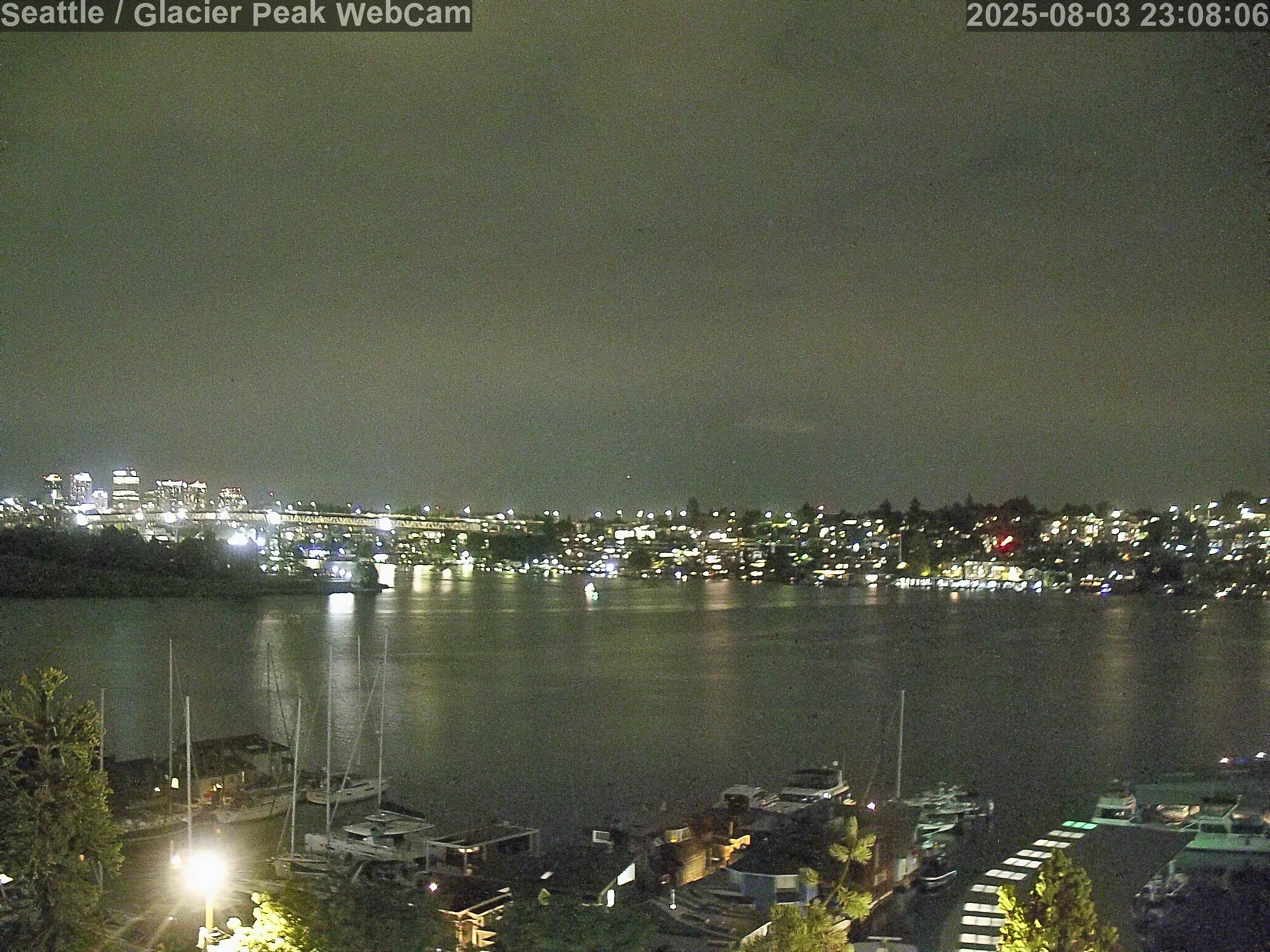 |
|
Simulation of the view from the webcam location at full wide-angle, showing visible peaks of the Cascade Range
using the View from Here function in CalTopo.
<click for full size (2240 x 1050) image>  |
|
|
PeakFinder diagram of the view from the webcam location at full wide-angle, showing visible peaks of the Cascade Range
along with sun paths on June 20 (longest day of the year), May 20 (similar to July 22), and April 20 (similar to August 22). <click for full size (2240 x 735) image> |
|
 |
|
|
Original Webcam, installed December 9, 2001: Full Size (640 x 480): |
|
 |
|
Conifers on the Webam Images: I've been growing about 2 dozen dwarf conifers in containers on my rooftop deck since June 2002, see my Dwarf and Slow-Growing Conifers page for information about the early years of that project. Strongly renewed interest, along with much better availability of many long-desired but hard-to-find conifer varieties, led to expanding the collection enormously during 2019 to reach an even 100 conifers by year end, gradually taking over most of the 260 sq ft deck and eventually turning it into a real garden of conifers. The expansion unexpectedly continued throughout 2020, magically creating new space numerous times by careful rearranging on a deck that seemed full already, to now include over 230 different kinds of dwarf, unusual, and rare conifers plus related gymnosperms (ginkgo and cycads). It has actually become a mini-arboretum of sorts too (a pinetum), with over 120 different species in 43 genera now represented in the "Amarboretum". This even includes over a dozen different kinds indoors, among the few species of conifers which can be successfully grown as houseplants (Araucaria, several genera of podocarps, plus cycads). And it features what may be the largest collection of redwoods and sequoias on any rooftop or deck in the world: 35 different cultivars of giant sequoia, coast redwood, and dawn redwood, which comprise the redwood subfamily Sequoioideae, and have always been my favorite conifers since childhood. |
|||
|
Full Wide-Angle Image from New HD Webcam, with good sunlight on the conifers: Quarter Size (640 x 480): <click for Full Size (2560 x 1920) image> |
Partly-Zoomed Image from Original Webcam, with good sunlight on the conifers and Glacier Peak visible at center: Full Size (640 x 480): |
||
 Several dwarf conifers on my deck are visible along the bottom of the new 2020 HD webcam image when it's fully zoomed out, including giant sequoias, Douglas firs, larch, and spruces: (left to right) Giant sequoia: Sequoiadendron giganteum 'Exceptionally Blue' (barely visible at farthest left) Giant sequoia: Sequoiadendron giganteum 'Pendulum' (narrow weeping form, with over 40 cones!) Giant sequoia: Sequoiadendron giganteum 'Von Martin' (top just barely visible) Giant sequoia: Sequoiadendron giganteum 'Blauer Eichzwerg' (top just barely visible) Douglas fir: Pseudotsuga menziesii 'Aureovariegata' (bright golden-yellow in spring) Douglas fir: Pseudotsuga menziesii 'Graceful Grace' (narrow weeping form) European larch: Larix decidua 'Pendula' (narrow weeping form, deciduous, golden-yellow during autumn) Colorado spruce: Picea pungens 'Baby Blue' (very blue in real life, much more so than on camera) Engelmann spruce: Picea engelmannii 'Blue Magoo' (very blue, semi-weeping, top just visible in front of next listed) Serbian spruce: Picea omorika 'Pendula Bruns' (narrow weeping form) Colorado spruce: Picea pungens 'Bakeri' (on my deck since 2002, just one branch visible behind the previous 2 listed) |
 As of 2020, several dwarf conifers on my deck are visible on the original webcam too when it's not zoomed in on Glacier Peak, including firs, false-cedars, cypresses, and arborvitae: (left to right) Korean fir: Abies koreana 'Horstmann's Silberlocke' (on my deck since 2003, far-left rear, silvery foliage, often with cones!) Port Orford cedar: Chamaecyparis lawsoniana 'Imbricata Pendula' (left, also pendulous branches hanging down from above) Port Orford cedar: Chamaecyparis lawsoniana 'Wissel's Saguaro' (far-left front, barely visible) Nootka cypress: Cupressus nootkatensis 'Sparkling Arrow' (center, creamy-yellow variegated foliage, top just visible) Hiba arborvitae Thujopsis dolabrata 'Variegata' (right-center, creamy-white variegated foliage, top just visible) Arizona cypress: Cupressus arizonica 'Blue Ice' (very blue, far-right front) Subalpine fir: Abies lasiocarpa 'Arizonica Compacta' (on my deck since 2002, fairly blue, far-right rear) When zoomed out to wider angle, several more conifers become visible too, including pines and junipers: (left to right) Limber pine: Pinus flexilis 'Cesarini Blue' (very blue, far-left rear) Bristlecone pine: Pinus aristata (my very first conifer, on my deck since 2002, left rear) Rocky Mountain juniper: Juniperus scopulorum 'Skyrocket' (very blue, center-left rear) Port Orford cedar: Chamaecyparis lawsoniana 'Imbricata Pendula' (pendulous branches now fill the upper part of the view) Western red cedar: Thuja plicata 'Cuprea' (on my deck since 2002, lower right) |
||
|
Foggy Image from New HD Webcam, which makes the conifers most clearly visible, lit by stray light from inside the condo: Quarter Size (640 x 480): <click for Full Size (2560 x 1920) image> |
Wider-Angle Image from Original Webcam, with more conifers visible (will change image to one with better sunlight soon): Full Size (640 x 480): |
||
 |
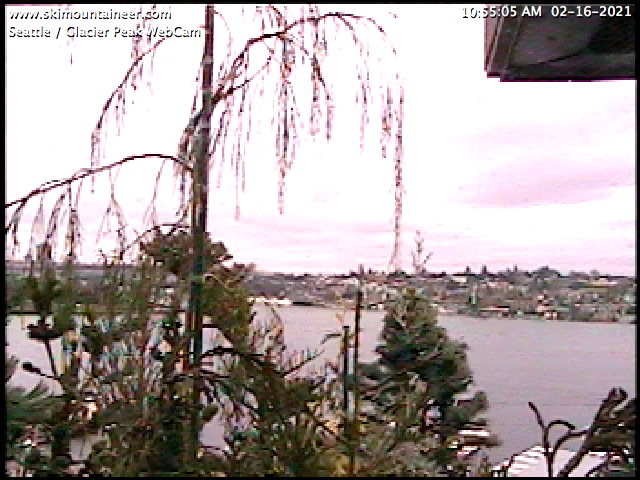 |
||
|
Technical Details of the New 2020 HD Webcam System: (installed November 13, 2020) The images come from a fairly inexpensive ($230 on Amazon) outdoor pan-tilt-zoom (PTZ) wifi security camera, with 5-megapixel (2560x1920) resolution and a (claimed) 30x optical zoom. This provides very high-quality HD images and excellent low-light performance, with bright full-color images even at night (the webcam includes infrared nighttime capability too, but this is not needed given the amount of ambient light near Lake Union). However, unfortunately the maximum zoom of this webcam actually appears to be only about 12x, based on measuring the pixel width of the same structures in each image — definitely not 30x as advertised and listed in the specs. The field of view appears to be comparable to a 42-500 mm zoom lens on a standard 35 mm film camera. But the HD images are very high-quality, especially at night, so I may end keeping this camera instead of returning it and trying to buy a different 30x (or 25x / 20x) camera, hoping that the other one will have the correct specified zoom along with equally sharp images and good low-light performance. It might be a lot of hassle only to find that none or few of the inexpensive 20x-25x-30x webcams on the market actually have their true specified zoom, or those that do may have other limitations or issues. The upgrade to a new HD camera has been long overdue for many years, as the images from the original 2001 webcam have looked small, grainy, and archaic since at least 2010. But it was not possible to find any inexpensive pan-tilt-zoom cameras with a long zoom range until the past few years, and I just wasn't willing to pay $1500-2500 for a professional-grade 30x PTZ camera. The new webcam is mounted outdoors about 8 ft above my deck, using a home-made aluminum bracket which hangs from metal flashing below the gutter, to avoid drilling holes into the stucco exterior of my condo building. |
||||||
|
Sample Images: The following examples show how the webcam image looks at varying degrees of zoom (the camera was not moved between the shots) and also in low-light conditions. |
||||||
| Wide-angle 1x (FOV = 46°) | 2x (FOV = 23°) | 3x (FOV = 16°) | ||||
 |
 |
 |
||||
| <click to enlarge> |
<click to enlarge> | <click to enlarge> | ||||
| 6x (FOV = 8°) | Maximum zoom, 12x (FOV = 4°) | Simulated 30x using Photoshop (FOV = 1.6°) | ||||
 |
 |
 |
||||
| <click to enlarge> |
<click to enlarge> | <click to enlarge> | ||||
 |
 |
 |
||||
| The nearly-full moon rises over Lake Union. <click to enlarge> |
Dawn over Lake Union. <click to enlarge> |
A typical nighttime scene on Lake Union. <click to enlarge> |
||||
|
Other interesting scenes captured by the new HD Seattle / Glacier Peak WebCam:
|
||||||
 |
 |
 |
||||
| A rare Seattle rainbow over Lake Union in December, the first one captured by the new webcam. <click to enlarge> |
Another rainbow over Lake Union, just a half-hour after the first. <click to enlarge> |
Another rainbow over Lake Union in February, this time a full rainbow with partial double-rainbow. Only part of the main rainbow is visible in the image, as the webcam's field-of-view of 46° is not nearly wide enough to capture a full rainbow (84° wide). <click to enlarge> |
||||
 |
 |
 |
||||
| A rare Seattle snowfall on the first evening of winter, with massive snowflakes over 1 inch diameter at times, but less than 1/4 inch accumulation. Shockingly, the temperature had been 59 °F only a few hours earlier in the day! <click to enlarge> |
A large ship with a forward gun and white paint covering all previous identifying marks, being towed into Lake Union from the Ballard Locks and Puget Sound in January 2021. It appears to be a decommissioned 378 ft long Hamilton-class Coast Guard cutter, possibly the USCGC Mellon, which was based in Seattle and decommissioned in August 2020. Please email me (link at bottom of page) if you can positively identify this specific ship, thanks! <click to enlarge> |
Profile drawing of a Hamilton-class Coast Guard cutter, which appears to be a very close match to the ship pictured at left. <click to enlarge> |
||||
|
The Great Seattle Snowstorm of 2021: February of 2021 brought the largest single snowfall I have experienced in 27 years of living in Seattle since September 1994, with over 10" falling on my deck at 100 ft above sea level from the evening of February 12 through midday February 13. Large snowfalls in the city of Seattle and surrounding areas near sea level in western Washington are quite rare, despite the very northerly latitude of 47.5°, farther north than the northernmost tip of Maine. And despite the nearby Cascade Range receving mammoth snowfalls averaging 30 to 50 feet or more per year at many locations, including the two snowiest measurement sites in the entire world: Paradise on Mount Rainier (5400 ft elevation, 680" average annual snowfall, 1122" record seasonal snowfall in 1971-72) and Mount Baker Ski Area (4200 ft elevation, 650" average annual snowfall, 1140" record seasonal snowfall in 1998-99, see my Cascade Snowfall and Snowdepth page for more info). In sharp contrast, the official "Seattle" weather data site located at SeaTac Airport (400 ft elevation, 11 miles south of downtown Seattle and 13 miles south of my deck) has an average annual snowfall of only 12" since 1945 with a maximum of 68" in 1968-69, while the National Weather Service office in Seattle at Sand Point (60 ft elevation, 5 miles northeast of my deck) has an average annual snowfall of only 4" since 1986 with a maximum of 18" in 1996-97, which is much more repreentative of the snowfall in most of the city except the hilltops. The maritime influence of the nearby Pacific Ocean and its large embayment of Puget Sound keeps temperatures near sea level just too warm too often to allow more frequent and voluminous snowfall, while elevations of just a few thousand feet above sea level are sufficiently cooler to produce regular and prodigious snowfalls. This snowfall event conisted of 3 storms in succession each about one day apart, with cold modified-Arctic air already in place for a couple days before the first storm. This brought 0.5" of snow on my deck from noon to midnight on February 11, with 0.5" also at the NWS Seattle Weather Forecast Office (WFO) but only a trace at SeaTac Airport. The second system from the evening of February 12 through the afternoon of February 13 brought at least 10" on my deck, with 7.2" at the Seattle WFO and 11.1" at SeaTac. The last system brought snow on the morning of February 14 changing to rain in the afternoon, with over 1" of snow on my deck and 1.3" at both the Seattle WFO and SeaTac. The preliminary climatological data from the NWS are shown below, with the relevant data highlighted in the blue boxes.  |
||||||
| Prelude, 0.5" snow: February 11, 2021 | Main Act, 10" snow: February 12-13, 2021 | |||||
 |
 |
 |
||||
| Snowfall began on February 11, this time with much colder temperatures in the 30s °F all day and very light snow starting at noon, with small flakes accumulating only about 1/2 inch on the conifers by midnight. <click to enlarge> |
The next storm started with very light snow around 6pm on February 12, intensifying overnight and continuing throughout most of the next morning with small flakes. Snowfall was almost 8" by sunrise, view angling down directly at the snow-sovered conifers. <click to enlarge> |
View looking downward at the deck, stool, and yardstick, an hour later with about 9" snow. <click to enlarge> |
||||
 |
 |
 |
||||
| Snowfall continued through the morning, with a maximum depth of 10" on my deck after 10am. <click to enlarge> |
View at the same time from the old webcam, 10am with 10" of snow. <click to enlarge> |
After a pause in snowfall around midday, additional snowfall resumed the rest of the afternoon with very large flakes, just enough to offset settlement, perhaps 1" new. <click to enlarge> |
||||
| Postscript, 1" snow: February 14, 2021 | ||||||
 |
 |
 |
||||
| The last snowstorm began around 7am the next day, with warmer temps and very large flakes. By 9:30am there was over 1" new snow, but warming continued and the snow began settling. <click to enlarge> |
View at the same time from the old webcam, 9:30am with 1" new snow. <click to enlarge> |
Snowfall continued into early afternoon, but the snowpack was shrinking at the same time. Sadly by mid-afternoon it had changed over to rain, and the snowpack began quickly vanishing. <click to enlarge> |
||||
|
Technical Details of the Original 2001 Webcam System: (installed December 9, 2001) The images come from a Canon ES60 Hi8 camcorder, which was pretty much the cheapest camcorder available on the market as of 2001. Its best feature is a 22X optical zoom, which allows for a much greater range of scenic possibilities than most typical webcams. This camera also has good low-light sensitivity, so that the picture during twilight often appears somewhat brighter than what the naked eye sees. The camera is mounted on a rigid aluminum angle bracket on the wall beside my living room window, and enclosed within a box made of foam-core board, in order to keep out stray light and prevent ghost images (i.e. the camera seeing the reflection of its own lens in the window). The signal from the camera goes via an S-Video cable to an old ixMicro ixTV video capture board mounted within an aging Power Macintosh G3, where the webcam software, Oculus 3.1, adds the captions and then uploads the images by FTP to this website. Over the years since 2001, the computer hardware and software have been upgraded a couple of times, to a setup using the InterView USB video capture device on a Power Macintosh Dual G4 and later a Mac Pro (2008, 8-core) running Mac OS X with ImageCaster as the webcam software. Somewhat remarkably, the original Canon ES60 Hi8 camcorder still continues to function perfectly as of November 2020, with minimal change in image quality despite 19 years of continuous operation, 24 hours a day, 7 days a week. During that time, the webcam software has captured and uploaded 288 images per day at 5-minute interals (except for outages), a total of over 100,000 images per year and almost 2 million cumulatively. |
||||||
|
Sample Images: The following examples show how the webcam image looks at varying degrees of zoom (the camera was not moved between the shots). The horizontal field-of-view (FOV) is calculated based on the actual 3.2 mm width of the so-called "1/4-inch" CCD in the camcorder, using the formula FOV = 2arctan(0.5*width/FL), where the focal length (FL) of this zoom lens varies from 3.6-79.2 mm. Remarkably, this is equivalent to a 40-890 mm zoom lens on a standard 35 mm film camera. |
||||||
| 1x (FOV = 48°) | 2x (FOV = 25°) | 4x (FOV = 12.7°) | ||||
 |
 |
 |
||||
| <click to enlarge> |
<click to enlarge> | <click to enlarge> | ||||
| 8x (FOV = 6.4°) | 16x (FOV = 3.2°) | 22x (FOV = 2.3°) | ||||
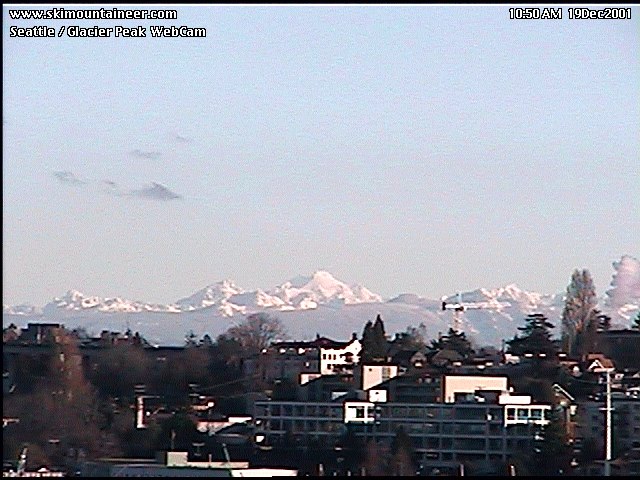 |
 |
 |
||||
| The Cascade Range rises in the distance above the busy skyline of East Lake Union. <click to enlarge> |
On this day, the summit of Glacier Peak was completely enveloped for several hours by a large lenticular cloud. <click to enlarge> |
Glacier Peak on a crisp December morning, with the rocky spire of Sloan Peak at left. <click to enlarge> |
||||
|
In addition to its impressive 22X optical zoom, the Canon ES60 also features a
700X digital zoom capability, which (when enabled) is simply applied on to the maximum
optical zoom. The combined effect of these is shown in the following three images.
The major flaw of digital zoom is that it increases noise and blurs the image, since
it has no extra "real" pixels to work with, and this effect is easily seen in these
photos. Beyond about 100X, the image of Glacier Peak blurs into a sea of foamy noise.
|
||||||
| 32x (FOV = 1.6°) | 44x (FOV = 1.2°) | 64x (FOV = 0.8°) | ||||
 |
 |
 |
||||
| <click to enlarge> |
<click to enlarge> | <click to enlarge> | ||||
|
Other interesting scenes captured by the Seattle / Glacier Peak WebCam: |
||||||
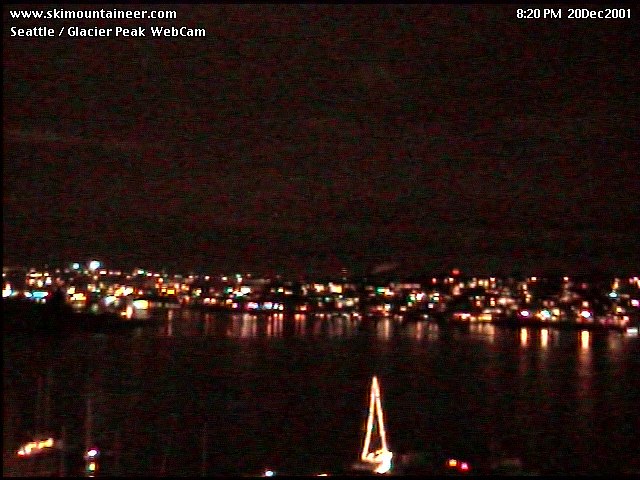 |
 |
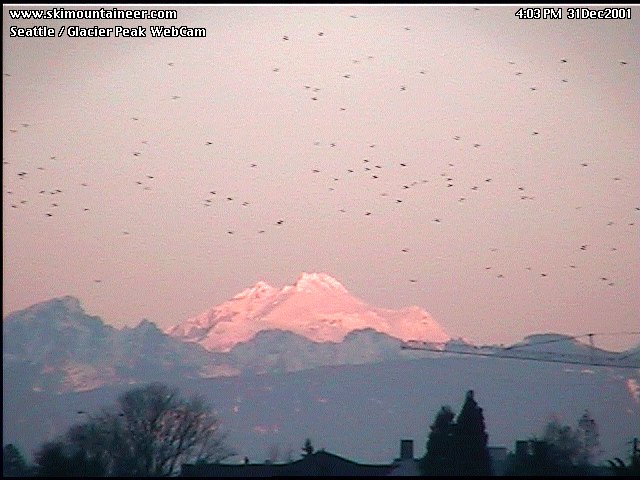 |
||||
| A typical nighttime scene on Lake Union. <click to enlarge> |
A floatplane coming in for a landing at the Kenmore Air harbor at the south end of Lake Union. <click to enlarge> |
A huge flock of birds flies by in the distance. <click to enlarge> |
||||
 |
 |
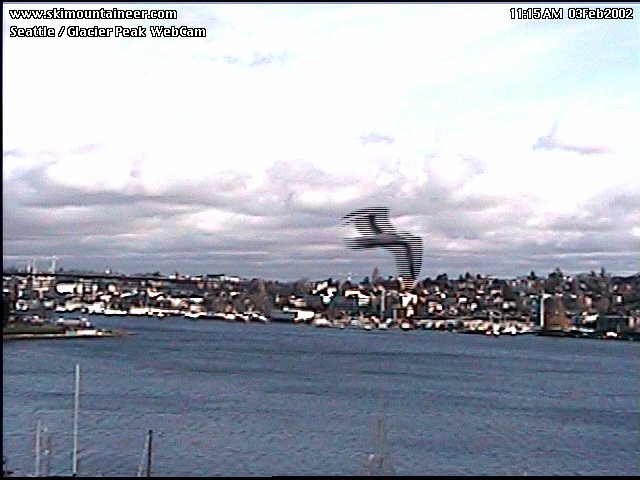 |
||||
| The full moon rises over Lake Union. <click to enlarge> |
A large ship, the 274 ft long
R/V Thomas G. Thompson of the
UW School of Oceanography, heading out of Lake Union towards the Ballard Locks and Puget Sound. <click to enlarge> |
A seagull swoops past the camera just beyond my deck (the image of the bird is split along parallel lines due to the interlacing of the NTSC video signal). <click to enlarge> |
||||
 |
 |
 |
||||
| Fireboat spraying water on Lake Union, February 2002. <click to enlarge> |
Fireboats spraying water on Lake Union, August 2002. <click to enlarge> |
Fireboat on Lake Union with rainbow in the spray, August 2002. <click to enlarge> |
||||